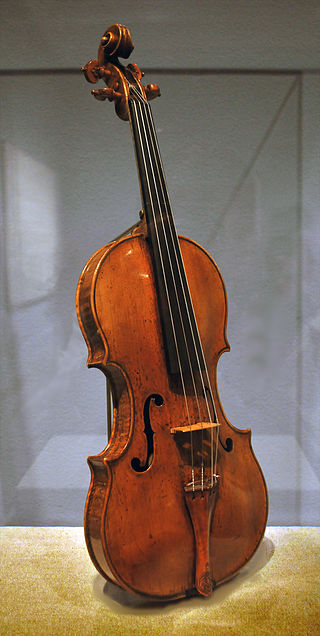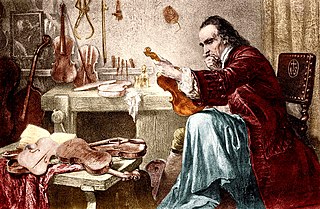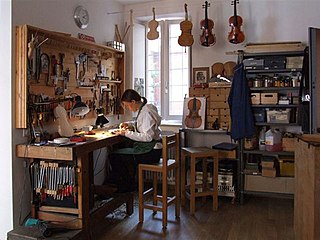
Amati is the last name of a family of Italian violin makers who lived at Cremona from about 1538 to 1740. Their importance is considered equal to those of the Bergonzi, Guarneri, and Stradivari families. Today, violins created by Nicolò Amati are valued at around $600,000. Because of their age and rarity, Amati instruments are mostly kept in museum or private collections and are seldom played in public.

Antonio Stradivari was an Italian luthier and a craftsman of string instruments such as violins, cellos, guitars, violas and harps. The Latinized form of his surname, Stradivarius, as well as the colloquial Strad are terms often used to refer to his instruments. It is estimated that Stradivari produced 1,116 instruments, of which 960 were violins. Around 650 instruments survive, including 450 to 512 violins. His instruments are considered some of the finest ever made, and are extremely valuable collector's items.

A Stradivarius is one of the violins, violas, cellos and other string instruments built by members of the Italian family Stradivari, particularly Antonio Stradivari, during the 17th and 18th centuries. They are considered some of the finest instruments ever made, and are extremely valuable collector's items.

A luthier is a craftsperson who builds or repairs string instruments that have a neck and a sound box.

Giovanni Battista Guadagnini was an Italian luthier, regarded as one of the finest craftsmen of string instruments in history. He is widely considered the third greatest maker after Antonio Stradivari and Giuseppe Guarneri "del Gesù". The Guadagnini family was known for their violins, guitars and mandolins.

Charles Jean Baptiste Collin-Mezin (1841–1923) was a French maker of violins, violas, cellos, basses and bows. He was an Officier de l'Académie des Beaux-Arts and won gold and silver medals at the Paris Exhibitions in 1878, 1889, and 1900.

Jean-Baptiste Vuillaume was a French luthier, businessman, inventor and winner of many awards. His workshop made over 3,000 instruments.

The Stroh violin or Stroviol is a type of stringed musical instrument that is mechanically amplified by a metal resonator and horn attached to its body. The name Stroviol refers to a violin, but other instruments have been modified with the amplification device, including the viola, cello, double bass, ukulele, mandolin, and guitar. Johannes Matthias Augustus Stroh, an electrical engineer from Frankfurt, invented the instrument in London in 1899.

Carlo Bergonzi was an Italian luthier and is the first and most prominent member of the Bergonzi family, a distinguished group of luthiers from Cremona, Italy, a city with a rich tradition of stringed instrument makers. Today his instruments are highly valued for their workmanship and tone. Although he was historically assumed to have first apprenticed with Hieronymus Amati or Antonio Stradivari, he is now known to have been the student of Vincenzo Rugeri.
W. E. Hill & Sons is a British firm based in London that specialises in violins and other string instruments, and bows. It was also known as William Ebsworth Hill & Sons or William E. Hill & Sons.

Giovanni Grancino (1637–1709), son of Andrea Grancino, was one of the early Milanese luthiers, and may have worked with his brother, Francesco.
Sanctus Seraphin, also known as Santo Serafin, was a successful luthier, working in Venice. He closed his bottega (workshop) in 1741 but he continued to work in the bottega of Giorgio Serafin, his nephew, till his death in 1776. It is still unknown where he learned the art of violin making. His models were inspired to the Cremonese luthier Nicolò Amati.
Arthur Edward Smith, known as A. E. Smith, was an English-born Australian violin and viola maker whose violins and violas are prized for their 'excellence of tone' and 'decorative elements'. According to some musicians, "it is his violas that have the greatest reputation, being easily counted amongst the greatest ever created, regardless of era or nationality."
Pietro Giovanni Guarneri (1655–1720), also known as Pietro da Mantua or Peter Guarnerius of Mantua was a violin maker of the Guarneri family who also worked as a professional musician. Today his instruments are highly regarded, though quite rare. They are played by musicians such as Joseph Szigeti.
Stewart Pollens is an expert on historical musical instruments. His work includes restoration, analysis, and scholarly publication; and it embraces keyboard instruments as well as historical stringed instruments such as the violin and cello. Andrew Manze has called him "one of the world’s foremost authorities on musical instruments."
Marino Capicchioni was an Italian musical instrument maker.

Sámuel Nemessányi Hungarian: Nemessányi Sámuel was a Hungarian luthier, a maker of stringed instruments, such as: violins, violas, and cellos. Nemessányi is considered the most talented and important maker in the Hungarian violin-making school. During his lifetime, he was already acknowledged as the most outstanding craftsmen of stringed instruments in all of Hungary and his instruments are of great importance to Hungarians. His life and work strikingly parallel that of Italian luthier Giuseppe Guarneri del Gesù.

Andrea Postacchini was an Italian violin maker born in Fermo, known as "Stradivari of the Marches".
Vincenzo Rugeri, was an Italian luthier of string instruments such as violins, cellos, and, violas in Cremona, Italy. His instruments are noted for their craftsmanship and tone quality. Vincenzo came from a distinguished family of luthiers, the first of whom was his father, Francesco Rugeri. Despite the local tradition of artisan families laboring together through generations, Vincenzo left the family shop and set up a successful shop of his own in the center of Cremona. Vincenzo was the third son of luthier Francesco Rugeri. Vincenzo's work, like Francesco's, is influenced by Nicolò Amati's Grand Pattern model, however Vincenzo's work was distinguished from his father's by utilizing a lower arch inspired by Antonio Stradivari. An analysis of the body of his work reveals that the quality of Vincenzo's instruments is remarkable, perhaps even more so than his father's. Vincenzo's instruments, though less numerous, are valued at least equal to those of his father. A violin by Vincenzo Rugeri realized $502,320 on October 3, 2011 at Brompton's Auctions in London. Carlo Bergonzi was a distinguished apprentice of Vincenzo Rugeri.

Richard Tobin was an Irish luthier and maker of violins, violas, cellos and pochettes. Tobin's work was largely uncredited, often branded under the names of his employers and other shops that enlisted him for his sought-after workmanship. As a luthier, he has been described as "a genius". As well as being known for the quality of his instruments, Tobin is famous for the workmanship of his scrolls, of which it has been said "never did Antonio Stradivari cut better".












